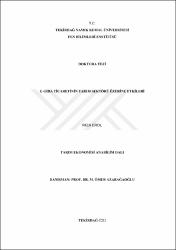| dc.contributor.advisor | Azabağaoğlu, Mecit Ömer | |
| dc.contributor.author | Erol, Rıza | |
| dc.date.accessioned | 2022-04-06T06:49:29Z | |
| dc.date.available | 2022-04-06T06:49:29Z | |
| dc.date.issued | 2021 | |
| dc.identifier.uri | https://tez.yok.gov.tr/UlusalTezMerkezi/TezGoster?key=v7BkNnnepTnbhn8rNR77LXjQCsqp9ftvi1qkQvN3HQ9TWd761yXhwzTDORP6N9F9 | |
| dc.identifier.uri | https://hdl.handle.net/20.500.11776/4136 | |
| dc.description.abstract | Dünyamız hızlı bir şekilde değişiyor. İnternetin bulunması ve yaygınlaşması ile mesafeler kısalmış iletişim artmıştır. Çağımız bilgi ve bilgiye sahip olanların sektörlere yön vereceği dijital çağ olma yolunda hızla ilerlemektedir. Özellikle 2019 yılının sonlarında dünyamızı saran COVİD-19 virüsünden sonra satın alma kültürü de hızlı bir değişim göstermeye başladı. Bu zaman diliminde sanal pazarda sektörlere göre bakıldığında en fazla büyümü gıda sektöründe olduğu görülmektedir. Günümüz ticaretinde üreticiden çıkan ürünleri hızlı bir şeklide tüketiciye daha az aracı kullanarak ulaştırmak önemli bir pazarlama figürü olmuştur. Bu nedenle geleneksel lojistik kanallarının yanına geliştirilmiş lojistik uygulamaları entegre edilmesi ile modern lojistik yöntemleri kullanılmaya başlanmıştır. Yakın gelecekteki lojistik kanalları ile ürünlerin tüketiciye ulaştırılması çok daha hızlı ve daha az maliyette olacaktır. Nakliyeden kaynaklanan ürün kayıpları azalacak, aracı kurumların sayısı düşürüldüğü için tüketici talep ettiği ürüne istediği üreticiden daha uygun fiyata ulaşmış olacaktır. Gelecekte fiziksel mağazaların yerini lojistik destekli sanal pazarlar alacaktır. Tarım ve gıda sektörü de yeni ticaret düzenine hızlı bir şekilde uymak için çalışmalara başlamalıdır. Ülkemiz olarak milli hassasiyet duyduğumuz tarım sektörü için yetkili kurumlar kamusal ve yapısal değişiklikleri yaparak sektörü desteklemek zorundadır. Tarım ve gıda sektöründe sanal pazar kanalları kullanımı arttırıldığı zaman ve üreticilerin bu kanalları kullanması teşvik edildiğinde çiftçinin geliri artacaktır. | en_US |
| dc.description.abstract | Our world is changing rapidly. With the discovery and widespread use of the Internet, the distances have been shortened and communication has increased. Our age is rapidly advancing towards becoming a digital age where those who have knowledge and knowledge will guide the sectors. Especially after the COVID-19 virus that surrounded our world at the end of 2019, the purchasing culture started to change rapidly. When we look at the sectors in the virtual market in this period of time, it is seen that the highest growth is in the food sector. In today's trade, it has been an important marketing figure to deliver the products from the manufacturer to the consumer using less vehicles. For this reason, modern logistics methods have begun to be used by integrating developed logistics applications alongside traditional logistics channels. In the near future, the delivery of products to the consumer will be much faster and less costly with logistics channels. Product losses due to transportation will decrease, as the number of intermediary institutions is reduced, the consumer will have access to the requested product at a more affordable price than the desired manufacturer. In the future, physical stores will be replaced by logistics supported virtual markets. The agriculture and food sector should also start working to adapt quickly to the new trade order. Authorized institutions for the agricultural sector, which we feel nationally sensitive as our country, have to support the sector by making public and structural changes. When the use of virtual market channels in the agriculture and food sector is increased and producers are encouraged to use these channels, the income of the farmer will increase. | en_US |
| dc.language.iso | tur | en_US |
| dc.publisher | Tekirdağ Namık Kemal Üniversitesi | en_US |
| dc.rights | info:eu-repo/semantics/openAccess | en_US |
| dc.subject | Ziraat | en_US |
| dc.subject | Agriculture | en_US |
| dc.title | E-gıda ticaretinin tarım sektörü üzerine etkileri | en_US |
| dc.title.alternative | Effects of e-food trade on the agricultural sector | en_US |
| dc.type | doctoralThesis | en_US |
| dc.department | Enstitüler, Fen Bilimleri Enstitüsü, Tarım Ekonomisi Ana Bilim Dalı | en_US |
| dc.identifier.startpage | 1 | en_US |
| dc.identifier.endpage | 198 | en_US |
| dc.institutionauthor | Erol, Rıza | |
| dc.relation.publicationcategory | Tez | en_US |
| dc.identifier.yoktezid | 686608 | en_US |



















